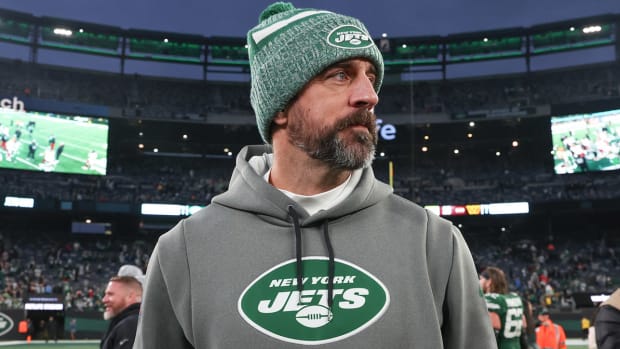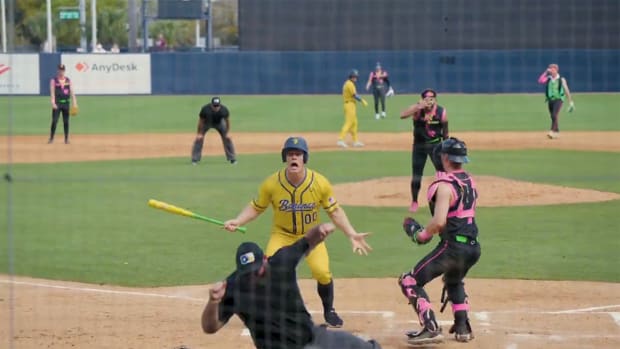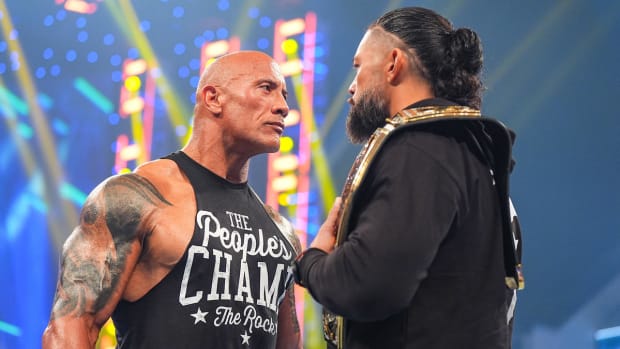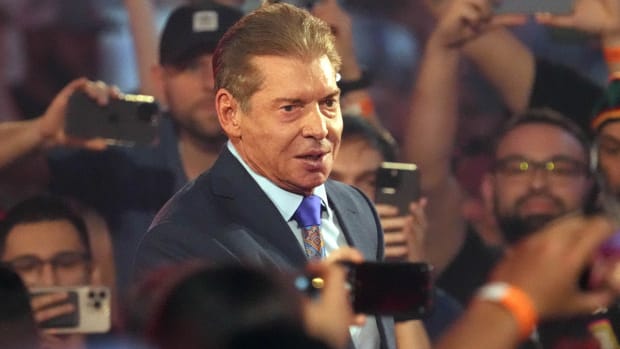'WrestleMania' Is Still On. Should It Be?
This weekend’s WrestleMania will be unlike any other in the event’s 36-year history: There will be no screaming fans, no fireworks, no military flyover. Due to the pandemic, “The Showcase of the Immortals” was taped on March 24–26 at multiple locations—chiefly the WWE Performance Center, the company’s training facility in Orlando—with only essential personnel present. It’s a far cry from what WWE had in mind when it booked the 65,000-seat Raymond James Stadium in Tampa for the event, but the company went to great lengths to ensure that even this version of its biggest annual moneymaker could go on.
But should it have?
Over the years, WrestleMania has evolved into WWE’s Super Bowl—an event held in sold-out NFL stadiums and bookended by days of additional WWE festivities. Last year’s edition generated nearly $17 million in revenue. Newly faced with well-funded competition in Turner’s All Elite Wrestling, WrestleMania is WWE’s once-a-year chance to flex as only it can. When the curtain is raised for WrestleMania 36 on Saturday, it will be a shockingly toned-down affair, but it will also be the only affair on the sports calendar.
From the onset of the coronavirus crisis, WWE has resisted altering its plans. In early March, when other U.S. sports organizations were discussing playing games without fans, Vince McMahon & Co. never wavered from WrestleMania going forward as normal. Even as late as March 13—after the NBA, NHL and MLB had suspended their seasons, March Madness had been canceled, the Masters postponed and multiple WWE events relocated—WWE released a statement saying it remained “committed to hosting WrestleMania at Raymond James Stadium on Sunday, April 5.”
McMahon is a longtime supporter and friend of President Donald Trump, who downplayed the risk of the virus for weeks. And McMahon’s wife, Linda, is a former Trump Cabinet member, who currently leads a pro-Trump super PAC. It took until March 16, the day Trump issued his guidelines “to slow the spread,” which urged Americans to avoid gatherings of more than 10 people, for WWE—which was also under pressure from local officials in Tampa—to finally acknowledge it was impossible for WrestleMania 36 to take place in front of 65,000 people at the Buccaneers’ stadium.
Even shooting WrestleMania on a closed set was unwise, says Zachary O. Binney, an epidemiologist at Emory University focused on sports injuries and player health.
On Tuesday, March 24—just after WWE started taping WrestleMania—Florida’s Orange County, where Orlando is located, announced it was issuing a stay-at-home order, effective Thursday night at 11 p.m. That gave WWE just enough time to squeeze its filming in, even if the company was obeying much more the letter of the order than its spirit. By the time WWE completed its tapings, “the virus was already spreading very widely” in Florida, Binney says. “I think it was dangerous then. I think it would be slightly more dangerous now, but it was already too dangerous.”
Before Orange County’s shutdown, WWE had also been filming other fan-free shows at the Performance Center. After Florida announced a statewide lockdown this week, AEW, which has been similarly filming without fans, moved production from Jacksonville to Georgia, but WWE has not yet said how it intends to proceed. Up to this point, though, WWE says it has taken the proper precautions to ensure that its employees are safe, instituting a protocol it believes will prevent the virus from spreading at the Performance Center.
“No one person, regardless of who they are, is allowed to enter if they have a temperature of over 100.4, or if they have been out of the country or been in touch with someone who has been out of the country,” WWE chief brand officer Stephanie McMahon told Sports Illustrated’s Justin Barrasso.
“We also do pandemic-level cleaning, which includes fogging and ultraviolet light, in the facility every single night. That could be overkill, quite frankly, but we really are trying to put in the best safety practices that we possibly can, given the circumstances.”
In a statement to SI, a WWE spokesman added, "Only essential personnel are on-site and social distancing is practiced outside of in-ring performances," saying that the company's protocols were developed by a team of doctors. "When widespread testing becomes available, all talent will be tested before performing," the spokesperson said.
It’s better than nothing, but Binney says it’s not nearly enough.
“Those safeguards are insufficient,” he says. “The problem with temperature checks is not everyone who gets COVID-19 has a fever. And we know that not everyone who gets COVID-19 has symptoms. Up to one-third or maybe more cases are completely asymptomatic. That means you can have the virus and be contagious and spread it to others while showing absolutely no signs of infection other than a positive COVID-19 test.”
Binney said that nightly disinfections are good, but do nothing to safeguard against someone carrying the virus into the facility. “You’re wrestling a match, you’re sweating, you might be accidentally spitting on different surfaces,” he says. “Nightly cleanings are not going to take care of that.”
The challenge of filming WrestleMania safely, even without fans, reflects the same issues the U.S.’s pro sports leagues will likely face when they seek to start back up. Binney says that to do it responsibly, WWE would have had to isolate and test every person involved—from support staff to talent—and then make sure they were not in any position to be infected in the time between receiving their test and traveling to the Performance Center for filming. It’s a near impossible task and, given the national testing shortage, an impractical one. “There was no way to do it safely,” Binney says.
At least one WWE performer decided the risk was not worth it. Roman Reigns (real name Joe Anoa’i) is a 33-year-old two-time leukemia survivor and one of the promotion’s biggest stars. Had the show gone forward at Raymond James as intended, he likely would have defeated Goldberg to win the universal championship, providing him with a career-defining moment on the industry’s biggest stage. But Reigns decided, due to his compromised immune system, not to take part in the show.
In that interview, Stephanie McMahon told SI that every employee’s participation is voluntary, but not every member is Roman Reigns. It’s tough to envision an up-and-coming wrestler pushing back against WWE brass, or for that matter, passing on such a potentially career-changing opportunity.
Safety issues aside, holding WrestleMania under such extreme restrictions could damage WWE in the long term, even if it fills its coffers today. Shane Toepfer, an assistant professor of media studies at the University of North Georgia who has studied WWE for 15 years, says this surreal, controversial version of WrestleMania is “detrimental” to the brand of the company’s signature event.
“By calling what’s about to happen—or has happened—WrestleMania, they are perhaps doing themselves a disservice, because no matter how we look at this, I don’t think any fans are going to feel particularly celebratory about it,” Toepfer says.
The safety of those involved in the production of the event isn’t the only concern, either. There’s also the question of the message WWE’s example sends to its fans, many of whom are young.
While millions of Americans were being instructed to avoid the outside world as much as possible, nearly 50 wrestlers took part in filming WrestleMania, some of whom traveled from out of state to be in Orlando.
“I do think it sends a negative message to fans,” Toepfer says. It’s not just that some fans could be led to dismiss social distancing, he says, but it’s “a negative message in terms of, we need to maintain business as usual—and that that is decidedly not the case in the situation we’re in right now. I think that message of ‘Just adapt, but we’re still going to maintain and press forward’—again, we saw it in 1999 when Owen Hart fell to his death—this is how the company operates. The show does go on, and they don’t take well to any sort of impediment to that.”
WWE sees its decision to plow ahead with WrestleMania as almost a public service.
“We consider it a privilege and, in some regards, a responsibility to be able to provide this entertainment value for our fans,” Stephanie McMahon told SI.
Toepfer isn’t totally buying the sentiment.
“I do think, to an extent, that there is sincerity in that,” he says, adding though that the company tends to paper over its controversies by presenting itself as wholesome entertainment. “Whether it’s the exorbitant amount of deaths in the wrestling industry in years past, or the Saudi Arabia example how they said they were actually spreading democracy and progress to Saudi Arabia, or whether in this instance it is, ‘Hey, look at how we’re here for you and our sacrifice for you.’ I think there’s a simultaneous self-serving bias going on there.”
The WWE spokesman responded, "The only message that we are sending is we believe it is now more important than ever to provide people with a diversion from these hard times. As a brand that has been woven into the fabric of society, WWE and its Superstars bring families together and delivers a sense of hope, determination and perseverance."
Whatever the motivation, WrestleMania 36 is filmed and in the can. For better or worse, the show has gone on.





